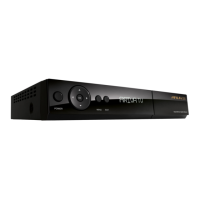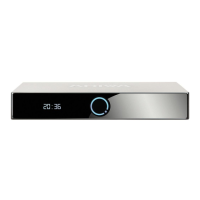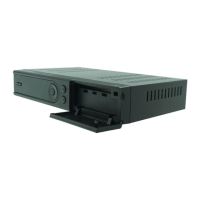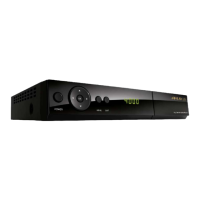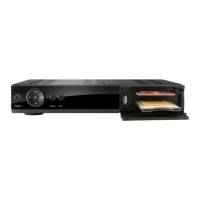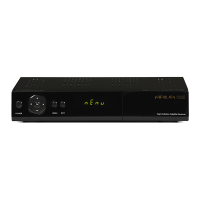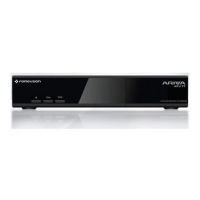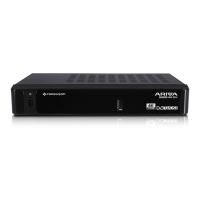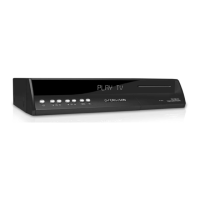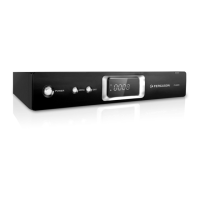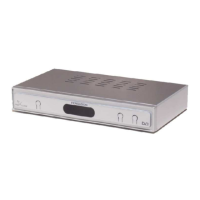Do you have a question about the Ferguson Ariva 255Combo and is the answer not in the manual?
Key reminders and limitations for using external USB memory for recording functions.
Critical warnings about handling USB devices during recording or playback to prevent damage.
Instructions to avoid electric shock, warranty voiding by opening the housing.
Advice on device placement, ventilation, and avoiding heat, humidity, and water.
Guidelines for safe maintenance, cleaning, and cable connection procedures.
Information regarding the manual's content, manufacturer's disclaimers, and rights to amend.
Explanation of various logos and symbols applied to the receiver for compliance and safety.
Overview of main features including reception standards, channel search, and connectivity.
Lists all the elements included in the receiver package.
Explanation of the user interface, menu navigation, and function key usage.
Controls for power, mute, volume adjustment, and channel selection.
Buttons for menu access, navigation, and adjusting display resolution.
Features for accessing EPG, program details, teletext, audio, subtitles, and channel search.
Controls for accessing media, recording, playback, time shift, and favorite channels.
Step-by-step instructions for installing batteries in the remote control unit.
Overview of buttons and slots on the receiver's front panel.
Procedure for inserting a CAM module and subscriber's card into the receiver.
Critical warning against removing or inserting modules while the receiver is on.
Details the various input and output ports available on the rear panel of the receiver.
Guidance on antenna placement, adjustment, and signal checking.
Instructions for connecting antennas with positioners using USALS and DiSEqC 1.2.
Instructions for connecting terrestrial antennas for DVB-T reception.
Step-by-step guide for connecting the receiver via HDMI for high-quality video.
Procedure for connecting the receiver to a television using SCART cables.
Details on connecting external hard drives, including formatting and file systems.
Instructions for connecting another receiver via the LNB OUT socket.
Procedure for connecting the receiver to a local network using an RJ45 cable.
Instructions for connecting the receiver to a computer using an RS232 Null Modem cable.
Steps for initial power connection, TV input selection, and checking cable connections.
Explanation of the user interface and how to navigate menus using the remote control.
Description of the main menu and its six primary items accessible via the MENU button.
Introduction to the installation menu for setting antenna parameters and searching for channels.
Options for connecting fixed antennas or antennas with positioners, and for terrestrial/cable modes.
How to select satellites from the list for channel scanning and configuration.
Configuring detailed parameters for satellites, converter types, and positioner systems.
Understanding signal strength and quality bars for optimal antenna adjustment.
Guide to searching for channels from a single satellite with different search modes.
Procedure for searching channels from multiple satellites sequentially.
Explanation of transponders and how to view, edit, add, or remove frequencies.
Step-by-step guide to searching for new channels using transponder frequencies.
Process for automatically scanning terrestrial channels based on a saved DVB-T list.
Manual search methods for terrestrial channels using channel or frequency information.
Adjusting parameters for the terrestrial antenna, noting signal bar delays.
Instructions for accessing and configuring Cable TV (DVB-C) settings.
Procedure for automatically scanning Cable TV channels.
Manual search methods for Cable TV channels.
Setting the receiver menu language, audio tracks, and subtitle languages.
Configuring video resolution, aspect mode, video output, and digital audio output.
Adjusting image parameters such as brightness, contrast, saturation, and hue.
Setting the receiver's time and date, including GMT usage and summer time.
Enabling parental lock, setting menu/channel locks, and changing the default password.
Configuring OSD settings, including subtitle display, timeout, and transparency.
Setting the default channel that the receiver switches to upon startup.
Configuring remaining options like LNB power, channel play type, clock in standby, and auto standby.
Displaying detailed information about the receiver's software version and databases.
Restoring the receiver to its default factory settings, including channel lists.
Sending software, settings, or channel lists between receivers using an RS232 cable.
Accessing information about the subscriber's card in the card reader.
Updating the receiver's software using a USB memory device.
Configuring network settings like IP addresses, subnet masks, and DNS servers for Ethernet.
Updating the receiver's software via the internet using network connection parameters.
Configuring Network DDNS settings for dynamic DNS services.
Accessing network services and embedded games like Tetris, Othello, and Sudoku.
Displays information about connected USB memory devices and allows formatting.
Configuring recording preferences, including timeshift, record type, and file splitting.
Setting up to 32 events for automatic receiver switching for planned programmes.
Playing music files, supported formats, and player functions.
Viewing JPEG and BMP photos, and combining with music playback.
Playing back movie files, supported formats, codecs, and resolution limitations.
Warnings regarding playback issues like file corruption, copy protection, and resolution limits.
Playing back recorded programs, with options for blocking, deleting, or renaming.
Methods for quick viewing and scrolling through recordings during playback.
Procedure for safely removing USB memory devices to prevent data loss.
Editing the TV channel list using colored buttons for functions like FAV, Lock, Skip, Move, Edit.
Step-by-step guide on how to move channels within the TV channel list and save changes.
Steps for deleting channels from the TV channel list and confirming the action.
Procedure for adding channels to favorite groups and managing favorite group names.
Procedure for changing channel names and saving the updated list.
Editing the list of radio channels using colored buttons for functions like FAV, Lock, Skip, Move.
Option to remove all channels from the channel list, with a confirmation warning.
Defining and naming up to 32 groups of favorite channels.
Displays program guide, allowing selection for timer functions and viewing detailed info.
Function for quick channel search by entering letters and selecting from results.
Displays teletext content broadcast by the selected TV station.
Selecting available audio soundtracks, including AC3 surround sound via digital out.
Selecting available on-screen captions/subtitles, which depend on the broadcaster.
Recording the current channel to a connected USB memory device.
Methods for browsing and navigating within a recording while it is in progress.
Using the SEMI-TWIN TUNER to watch a different channel on the same frequency during recording.
Pausing and resuming live TV broadcasts using the time shift buffer on a USB device.
Scrolling through the time shift buffer to view earlier parts of a broadcast.
Recording the current contents of the time shift buffer.
Turning off the time shift mode using the STOP button.
Displaying current and next program information, and detailed weekly program information.
Displaying favorite groups and allowing access to created favorite lists.
Definitions for Conditional Access systems, CAM modules, and Common Interface sockets.
Definitions for DVB-S, LNB converters, and Transponders in satellite broadcasting.
Definitions for DiSEqC and USALS protocols used in satellite antenna control.
Definitions for Free-to-Air (FTA) and Pay-Per-View (Pay-TV) channel access.

